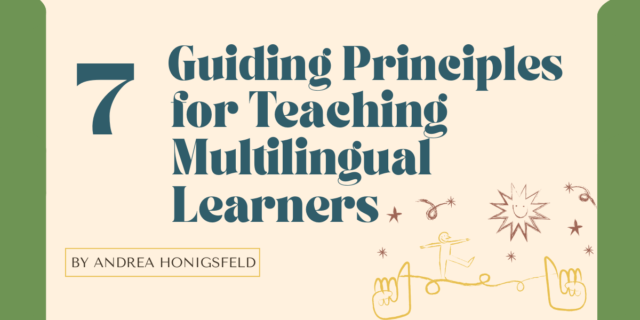
Supporting Multilingual Learners by Lindsey Moses is available now! The following is an outline of the 50 Instructional Strategies found in the book. Each section (or chapter) is based on one of the foundational ten research-based, easy-to-used scaffolds.
***
Connecting New Learning to Prior Learning and Experiences
1: RAN Chart with Multilingual Adaptations: Reading and Analyzing Nonfiction Chart
2: Anticipation Guide
3: Multimedia Preview and Preparation
4: Making Connections
5. Getting to Know your Students Through Asset Mapping (listen to the podcast!)
Teaching Academic Vocabulary
1: Semantic Mapping with the Frayer Model: maps, webs, or visual representations of words; modifiable to include 'In my home language'
2: List-Group-Label
3: Heads Up! Academic Vocabulary Version
4: Morphological Analysis
5: Partner-Practice-Place-Defend
Modeling Skills, Strategies, and Procedures
1: Model Classroom Procedures
2: Model Academic Procedures
3: Model Reading Strategies
4: Model Giving Feedback
5: Model Degrees of Proficiency for Student Critique
Using Visuals to Support Understanding
1: Visuals for Introducing Vocabulary and Building Background Knowledge: anchor charts or handouts
2: Total Physical Response: use gestures and physical movement
3: Typography That Supports Language Learning: use color-coding, underlining, and bolded print
4: Multimodal Documentation: sketchnotes, infographics, illustrated documentation, video creation, drama/theatre
5: Picture Word Inductive Model: teacher presents visual and students help collaboratively label picture
Adjusting Speech and Time
1: Adjusted Speech Rate Incorporating Videos
2: Extended Wait Time
3: Adjusted Time to Complete Tasks
4: Adjusted Time and Speech with Vocabulary
5: Adjusted Time of Teacher Support Versus Independent Work
Providing Repeated Exposure and Opportunities for Practice
1: Songs and Chants
2: Reinforcement Games
3: Vocabulary Tracking
4: Goal Setting and Monitoring
5: Connected and Integrated Units
Preparing Resources to Support Student Response
1: Word Banks
2: Sentence Stems
3: Graphic Organizers
4: Summary Frames
5: Guided and Cloze Notes
Preparing Structured Language Opportunities with Talk-Equity Considerations
1: Think-pair-share
2: Think-whisper-let it go
3: Talking Chips
4: Stand Up-Hand Up-Pair Up
5: Oral Language Development Groups
Connecting to and Building on Students’ Home Language Skills and Knowledge
1: Find, use, and read translanguaging books
2: Introduce and draw attention to cognates (words that are the same linguistic derivation and have identical or nearly identical spellings and meanings)
3: Use bilingual resources
4: Perform contrastive analysis
5: Use multilingual small reading groups
Drawing Attention to Language and Expanding Grammatical Complexity
1: Noticing, Naming, and Evaluating with Mentor Texts
2: Concept Attainment
3: Sentence Expansion
4: Analyzing and Upgrading
5: Application and Self-Checking
***

Designed for every K-5 classroom teacher, Supporting Multilingual Learners offers strategies to support the literacy development of children who speak multiple languages. Organized by 10 research-based, easy-to-use scaffolds, this practical guide shares:
- 50 strategies that teachers can use proactively or to respond to student needs
- Downloadable online planning templates
- Vignettes across grade levels showing the strategies in action
- Reflection questions for educators
Each chapter focuses on one scaffold and 5 instructional "Strategies in Action" that fit within that scaffold, providing classroom examples of the strategies in use.
Learn how to put multilingual learners front and center in your classroom with inclusive and supportive best practices.
Supporting Multilingual Learners is Available Now!


